Posts Tagged ‘British Forces’
-
FROM STORIES TO HISTORY
For hundreds of years, the recording of the past focused on public records, statistical data and the lives of prominent people. Yet in recent decades, the spotlight turned onto the general public and its memories in order to provide a more accurate picture of the historic narrative.
 “People who have lived through particular events can contribute different viewpoints and perspectives that fill in the gaps of documented history, at times correcting or even contradicting the written record. The project MEMORJA aims to give a voice to those who have been unheard,” explained James Baldacchino, the administrator of the MEMORJA Project.
“People who have lived through particular events can contribute different viewpoints and perspectives that fill in the gaps of documented history, at times correcting or even contradicting the written record. The project MEMORJA aims to give a voice to those who have been unheard,” explained James Baldacchino, the administrator of the MEMORJA Project.MEMORJA is an oral, sound and visual archive. Its main objective is to employ cutting edge research, methodologies, theoretical and archival approaches and techniques to collect, record, transcribe, preserve and make available and retrievable all the deposited material detailing the islands’ history.
“Work on this project has begun in January 2017. This is a new platform which is giving an additional dimension to the National Archives since this time, it is not only collecting records but reaching out to create them.”
At the early stages of the project, four themes were selected, namely the Second World War, British expatriates in Malta, public administration and the Lampedusa-Malta connection.
 “The theme related to experiences during the Second World War aims to document and record a past which is slowly disappearing from public memory especially with the passing away of the older generation. Oral testimonies and photographs serve to recollect the terrible years of war and what the people have lived through in those times. Stories of the outbreak of hostilities and the first bombings on June 11, 1940, the mass evacuations and refugee experiences, fear and uncertainty, hunger and the Victory Kitchens, shelters and sanitation, soldiers and sirens, and tragedies of bombings are part of the significant remembrance which needs to be collected and preserved for future generations before it is lost for good.”
“The theme related to experiences during the Second World War aims to document and record a past which is slowly disappearing from public memory especially with the passing away of the older generation. Oral testimonies and photographs serve to recollect the terrible years of war and what the people have lived through in those times. Stories of the outbreak of hostilities and the first bombings on June 11, 1940, the mass evacuations and refugee experiences, fear and uncertainty, hunger and the Victory Kitchens, shelters and sanitation, soldiers and sirens, and tragedies of bombings are part of the significant remembrance which needs to be collected and preserved for future generations before it is lost for good.”The history of the relationship between the UK and Malta is another central theme which has not been documented through the eyes of the British and Maltese individuals.
 “This section includes interviews with British and British-Maltese people who were either in the British forces during the 1960’s (or their spouses) and remained in Malta, or civilians who married a Maltese person and relocated to Malta. Such recordings open a window on everyday life in Malta during the 1950s – 1970s. Much of the narratives relate to military bases, post-war experiences, political issues, relationships and cultural differences. This theme was further expanded when the experience of service families’ children was included as well. These children had attended the Naval Childrens’ School and HM Dockyard Children’s School which had occupied sites at Ta’ Xbiex, Cottonera, Senglea and the Dockyard before moving to Tal-Ħandaq.”
“This section includes interviews with British and British-Maltese people who were either in the British forces during the 1960’s (or their spouses) and remained in Malta, or civilians who married a Maltese person and relocated to Malta. Such recordings open a window on everyday life in Malta during the 1950s – 1970s. Much of the narratives relate to military bases, post-war experiences, political issues, relationships and cultural differences. This theme was further expanded when the experience of service families’ children was included as well. These children had attended the Naval Childrens’ School and HM Dockyard Children’s School which had occupied sites at Ta’ Xbiex, Cottonera, Senglea and the Dockyard before moving to Tal-Ħandaq.” Civil servants are often regarded as those who are implementing the Goverment’s policies. However, through their memories we can get a glimpse of what happenned ‘behind the scenes’ during the most important political, social and economic decisions undertaken by Maltese political leaders.
Civil servants are often regarded as those who are implementing the Goverment’s policies. However, through their memories we can get a glimpse of what happenned ‘behind the scenes’ during the most important political, social and economic decisions undertaken by Maltese political leaders.“These include background revelations of what was taking place during the granting of Independence in 1964, the dismantling of the British military base in 1979 and how the Maltese prepared for such an event, membership in the EU and how it affected the civil service, the migration of the hospital from St Lukes to Mater Dei and many other memorable challenges.”
Lampedusa and Malta are two islands with different political histories. Yet to some extent they share similar economic, trade and socio-cultural interest.
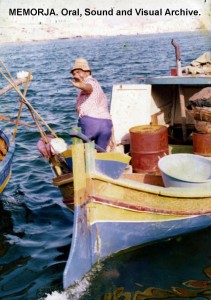 “We have an interest in Lampedusa since in the early 1800s, there were a number of Maltese settlers on this island. Until now, no one had attempted to record these people’s history in order to understand the link between the two islands. The MEMORJA Project is focusing on two time frames to investigate the islands’ shared history. The first one relates to the period from 1800 – 1843 when Lampedusa was colonised by Maltese settlers working in agriculture and animal husbandry. The second covers the period between the 1950s and the 1980s when Lampedusani fishermen visited Malta regularly for the maintenance of ships, the sale of blue fish and the provision of supplies.”
“We have an interest in Lampedusa since in the early 1800s, there were a number of Maltese settlers on this island. Until now, no one had attempted to record these people’s history in order to understand the link between the two islands. The MEMORJA Project is focusing on two time frames to investigate the islands’ shared history. The first one relates to the period from 1800 – 1843 when Lampedusa was colonised by Maltese settlers working in agriculture and animal husbandry. The second covers the period between the 1950s and the 1980s when Lampedusani fishermen visited Malta regularly for the maintenance of ships, the sale of blue fish and the provision of supplies.”As the team of the MEMORJA Project reached out to people, they were soon welcomed by the different communities who were eager to share their recollections.
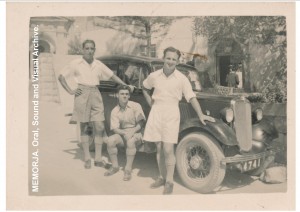 “We found a huge amount of data which existed only in the minds of people and in their photos. Many individuals were enthusiastic to make their voice heard in order to help out with the shaping of the public’s narrative which up to now was not formally recorded for posterity. Even though we have four selected themes, it does not exclude us from recording other memories as well which we deem to be of importance to form part of the community memory.”
“We found a huge amount of data which existed only in the minds of people and in their photos. Many individuals were enthusiastic to make their voice heard in order to help out with the shaping of the public’s narrative which up to now was not formally recorded for posterity. Even though we have four selected themes, it does not exclude us from recording other memories as well which we deem to be of importance to form part of the community memory.”The search for the stories which make the history is still going on. The final goal of the MEMORJA Project which will be officially launched later on this year will be to make this information accessible online for educational and research purposes.
 “Oral history allows people to express the personal consequences of change, from the simplest things in life to the more complex. It enables people to share their experiences in their own words, with their own voices, through their own understanding of what happened and why. Eventually, such documentation will offer depth to the understanding of the past to present and future generations.”
“Oral history allows people to express the personal consequences of change, from the simplest things in life to the more complex. It enables people to share their experiences in their own words, with their own voices, through their own understanding of what happened and why. Eventually, such documentation will offer depth to the understanding of the past to present and future generations.”If you are interested to contribute to the MEMORJA Project, you are invited to contact James Baldacchino on james.baldacchino@gov.mt or call 21459863.
The National Archives is located at ‘Santo Spirito’, Hospital Street, Rabat, Malta.
(This article was published in SENIOR TIMES – MAY 2018 issued with The Times of Malta dated 24 May 2018)
-
CORNER COMFORTS
 “You wouldn’t survive in this business if you are not brought up in it since childhood. It is just too demanding and it takes up your life completely,” insisted Frankie Cutajar, the owner of Lady Di Pub in Tignè Street, Sliema.
“You wouldn’t survive in this business if you are not brought up in it since childhood. It is just too demanding and it takes up your life completely,” insisted Frankie Cutajar, the owner of Lady Di Pub in Tignè Street, Sliema.“On the other hand, if the seed of entertainment has been nurtured in your blood from an early age, it is difficult to let go of such an engaging and colourful world,” he said as he laughed heartily and poured a tin of golden beer into a large glass for a client.
Cutajar hails from Valletta. Two of his family members are the renowned late musician Oscar Lucas and popular singer Joe Cutajar.
“Back in the old days, their cheerful attitude and exquisite talent used to light up the thrilling atmosphere of Strait Street. I can still remember the time when 10,000 foreign soldiers sought that area in Valletta each week and all those who had a business there, concocted new ways to attract them to their locale.”
“My uncle Oscar Lucas played in various venues. Together with Jimmy Grech (also known as Jimmy l-Irish), he owned the Las Vegas which was the first nightclub to open in Malta and boasted a capacity of 500 seats. It was huge, running from the area where today one finds the Marks and Spencer store and going up to the Embassy. At the age of 12, I worked as a commis waiter in this nightclub, serving customers which were mainly young couples, between 6:00pm and 8:00pm.”
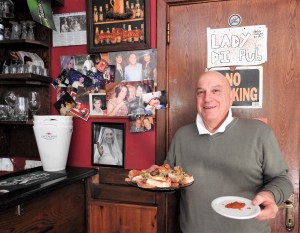 Cutajar got married when he was 18 and kept working at Las Vegas until it closed its doors.
Cutajar got married when he was 18 and kept working at Las Vegas until it closed its doors.“The British Forces’ departure from our islands drained all the energy from Strait Street, turning it into a shadow of what it was. Paceville became the new attraction for the younger generation while Valletta died out during the evenings. Eventually, Jimmy l-Irish, my older brother Harry and I acquired a bar in Melita Street and called it Pippo’s.”
“Later on, my brother and I also took over a business in Tignè Street, Sliema. This place was originally a bar known as Neriku and it was run by my grandfather and grandmother. After it served as an antique shop for some years, we decided to open it as a pub. Many of the visitors who came to Malta and stayed at the surrounding hotels in Sliema were British. So we had no doubts whatsoever about what we were going to name our new pub.”
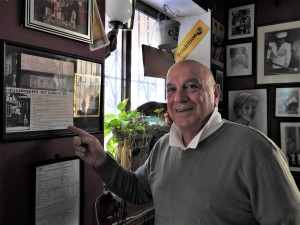 A framed copy of a newspaper feature which hangs on one of the walls narrates how the name Lady Di Pub came to life. Cutajar recounted this incident proudly.
A framed copy of a newspaper feature which hangs on one of the walls narrates how the name Lady Di Pub came to life. Cutajar recounted this incident proudly.“I was having a meal with a well-connected friend of mine at a London restaurant when he introduced me to Lady Diana. I told her that I would be naming a bar after her to record the memorable event of her marriage to Prince Charles. Shortly afterwards, I saw her again at a film premiere in Leicester Square and she reminded me about it.”
Lady Di Pub opened its doors right on Wednesday, 29 July 1981; the day of the eventful fairytale wedding.
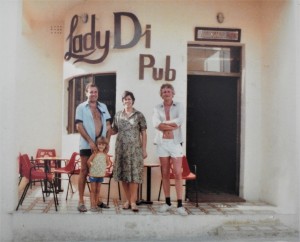 “This is how the pub looked at the time,” Cutajar said as he pointed at another old photo. “It consisted of just two small rooms. However, it had a very good clientele.”
“This is how the pub looked at the time,” Cutajar said as he pointed at another old photo. “It consisted of just two small rooms. However, it had a very good clientele.”Meanwhile, Pippo’s bar in Valletta was turned into Da Pippo’s restaurant and his brother Harry stayed to manage it. Frankie opted to run the pub in Sliema. In 2006, the Lady Di Pub was rebuilt after the property was earmarked for development and was demolished.
“Although the pub was new, I decided to recreate its old British soul. I knew that my clients would appreciate the warm feeling of a unique traditional corner huddled amongst the tall and modern buildings.”
In recent years, Sliema’s architectural context has changed considerably. Huge, inanimate buildings are replacing traditional stately homes, a small number of which still survive in Tignè Street.
“Times change and people have to move on with the progress which is generated. Sliema is not Valletta. Whereas Valletta is a historical city of culture, Sliema is a business hub and a touristic area. The more modernized it is, the more people it attracts, and the more customers will come to this pub,” Cutajar stated as he winked playfully.
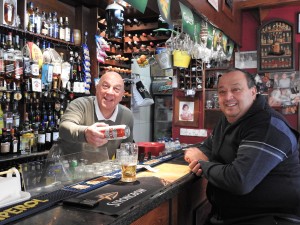 “His charismatic character and that of his son Keith who also works here are the secret of the success of this place,” revealed Ġanni Fenech, a regular client who was having a beer at the bar. “They have a way of making everyone feel welcome and they are also very good in the kitchen. The appetizers in this bar are always bountiful and delicious, urging you to keep on drinking so that the food continues to come out. Seasoned bread, pasta, ricotta and pea pies, cheesecakes… They simply taste like heaven with a glass of beer.”
“His charismatic character and that of his son Keith who also works here are the secret of the success of this place,” revealed Ġanni Fenech, a regular client who was having a beer at the bar. “They have a way of making everyone feel welcome and they are also very good in the kitchen. The appetizers in this bar are always bountiful and delicious, urging you to keep on drinking so that the food continues to come out. Seasoned bread, pasta, ricotta and pea pies, cheesecakes… They simply taste like heaven with a glass of beer.”Right on the point, Frankie came out of the kitchen with a plate of thickly sliced crusty Maltese bread spread with kunserva, a sweet tomato paste, and topped with olives, onions, lettuce and broad beans.
“Especially on Fridays and during weekends, Lady Di Pub is full of people and it stays open until the early morning hours. Some of our clients work in the nearby offices and come here to end the week in a good mood and meet friends. A number of others are regulars from Sliema including a small group of elderly people who have been gathering here each Sunday for the past 30 years! Other locals come from various areas around Malta. However, the majority of our clients are foreigners.”
Frankie starts his day at around 8:30am by doing errands, including buying fresh bread. After enjoying a coffee at a nearby coffee shop, he opens his pub at 10:00am. Soon, the first clients will come in and he starts preparing some inviting appetizers. By now, his long experience and a good knowledge of his clientele have furnished him with an invaluable insight of who will be calling at his pub on each day and what he will need to prepare.
 “We are here to make our clients feel comfortable. Should they wish to have lunch or dinner, we can cook anything to their liking, once they advise us beforehand. Last week, we cooked a selection of pasta, fried rabbit and rib-eye steak for a group, and they surely loved it!”
“We are here to make our clients feel comfortable. Should they wish to have lunch or dinner, we can cook anything to their liking, once they advise us beforehand. Last week, we cooked a selection of pasta, fried rabbit and rib-eye steak for a group, and they surely loved it!”Whilst the younger generation prefer to seek out Keith’s company, the older clientele feels closer to Frankie.
“I am 67 now but still going strong,” Frankie joked as he turned to a laptop and turned on some music. “Back in Valletta, we enjoyed live music at our nightclub. Until some years ago, I had a juke box here. Now I have to rely on this new technology. Flexibility is a must in such a business. Nowadays clients demand to hear particular songs while having a drink and this is the most practical way.”
Culture change is also evident in the choice of requested alcohol and in the clientele’s attitude.
“In the past, people preferred whisky especially Jack Daniels. We also served gin and vodka. Today, very few will ask for gin or vodka and the whisky which we sell is mainly J & B, Jameson, and Johnny Walker Black. Earlier generations used to come in and offer drinks to friends and to other people in the pub. We also had incidents when people got heavily drunk and still insisted to have more drinks. The present generation will generally order and pay for their own drinks, whether male or female. They are also more aware of the risks of over-drinking and they rarely get drunk.”
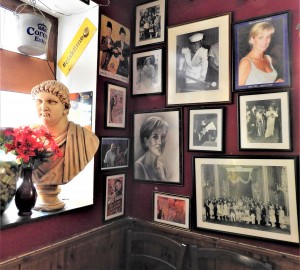 Several framed photos of Lady Diana keep a watchful eye over the pub’s customers.
Several framed photos of Lady Diana keep a watchful eye over the pub’s customers.“These were given to us by her photographer who became our friend,” Frankie explained. “Customers love to look at them especially now that she’s gone. She was very cherished by the people and they still miss her terribly.”
After her tragic death on 31 August 1997, Lady Diana’s fans were distraught. They frantically searched for anything which connected them to her.
“For a number of days after her demise, people left flowers at our doors as a sign of mourning. A British journalist for The People came to visit the pub and interviewed me about this experience. It was certainly a very disturbing loss but in this little corner in Malta, Lady Di’s memory is still very much alive.”
(This feature was published in SLIEMA TIMES – APRIL 2018 issued with The Times of Malta)
Travelogue
Archives
| M | T | W | T | F | S | S |
|---|---|---|---|---|---|---|
| « Jan | ||||||
| 1 | 2 | 3 | 4 | 5 | 6 | 7 |
| 8 | 9 | 10 | 11 | 12 | 13 | 14 |
| 15 | 16 | 17 | 18 | 19 | 20 | 21 |
| 22 | 23 | 24 | 25 | 26 | 27 | 28 |
| 29 | 30 | |||||
Recent Posts
- A MATTER OF FATE
- MALTA’S PREHISTORIC TREASURES
- THE MAGIC IS IN THE DETAIL
- THE SELLING GAME
- NEVER FORGOTTEN
- Ġrajjiet mhux mitmuma – 35 sena mit-Traġedja tal-Patrol Boat C23
- AN UNEXPECTED VISIT
- THE SISTERS OF THE CRIB
Comments
- Pauline Harkins on Novella – Li kieku stajt!
- admin on IL-KARNIVAL TRAĠIKU TAL-1823
- Albert on IL-KARNIVAL TRAĠIKU TAL-1823
- Martin Ratcliffe on Love in the time of war
- admin on 24 SENA ILU: IT-TRAĠEDJA TAL-PATROL BOAT C23